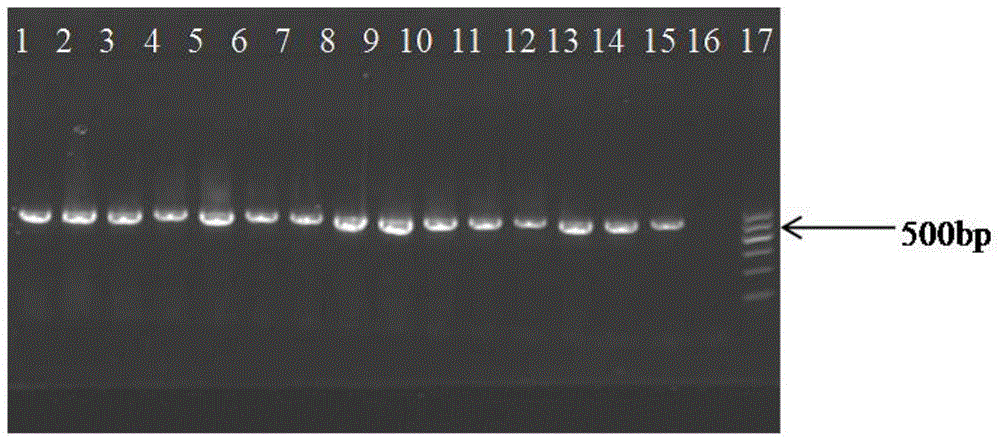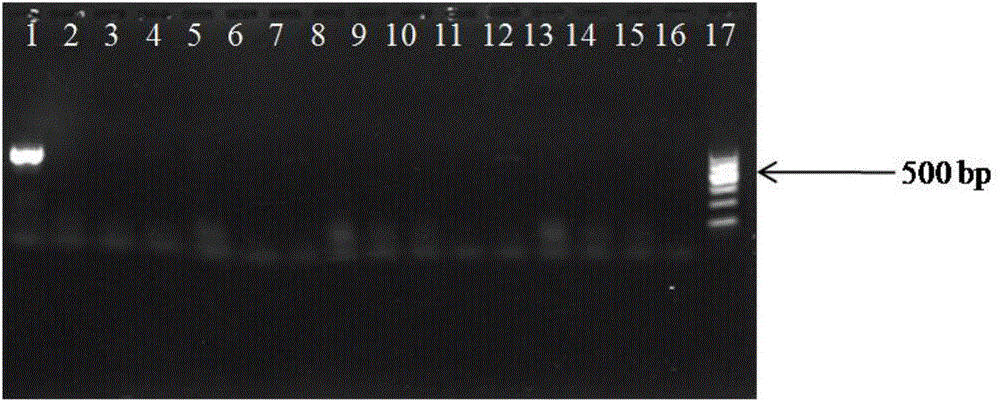Method for detecting lactobacillus casei strain and kit and primer pair used by method
A Lactobacillus casei and primer pair technology, applied in the biological field, can solve the problems of high cost, long detection time, time-consuming and laborious, and achieve the effects of low detection cost, simple result judgment, and improved detection efficiency.
- Summary
- Abstract
- Description
- Claims
- Application Information
AI Technical Summary
Problems solved by technology
Method used
Image
Examples
Embodiment 1
[0030] Embodiment 1 detects the primer synthesis and PCR detection of Lactobacillus casei bacterial strain
[0031] (1) Primer synthesis
[0032] Synthesize primers (synthesized by Shanghai Sangong Bioengineering Technology Service Co., Ltd.) that can PCR amplify the conserved sequence in the Lactobacillus casei histidine kinase gene sequence, and the primer sequences are as follows:
[0033] RR-L: 5'-ACCAACCACCAAACGATGCT-3' (its nucleotide sequence is shown in SEQ ID NO: 1 in the sequence table);
[0034] RR-R: 5'-AAGGTTGCGATTTCGCGTTC-3' (its nucleotide sequence is shown in SEQ ID NO: 2 in the sequence listing).
[0035] (2) PCR detection
[0036] Using the above primers, using the genomic DNA of Lactobacillus casei standard strain ATCC334 as a template, the PCR reaction system and reaction program were established and optimized. It was found that the following reaction system and reaction program can obtain a single amplification product of about 569p.
[0037] Wherein, t...
Embodiment 2
[0051] Embodiment 2 detects the specificity evaluation of Lactobacillus casei bacterial strain
[0052] 1), acquisition of strain genome DNA template
[0053] Get 1 strain (ATCC334) of Lactobacillus casei standard strain, 18 strains of Lactobacillus casei isolated bacterial strain and 14 strains (as shown in Table 1) of other varieties, collect thalline respectively according to the step described in Example 1 and press CTAB Genomic DNA was extracted by the method and used as a PCR reaction template for the detection of Lactobacillus casei.
[0054] 2), whether it is Lactobacillus casei strain detected by PCR
[0055] Take 2 μL of the DNA solution (DNA concentration: 30 ng / μL) of each strain obtained in step 1) and add it to the PCR reaction system as a PCR reaction template for amplification reaction.
[0056] The PCR reaction system is: 16.1 μL of sterile water, followed by adding 2.5 μL of 10×PCR reaction buffer, 25 mmol / L Mg 2+ 2.0μL, 2.5mmol / L dNTP 1.0μL, 5μM primer RR...
Embodiment 3
[0068] Embodiment 3 detects the sensitivity evaluation of Lactobacillus casei method
[0069] The method for extracting genomic DNA by the CTAB method described in Example 1 extracts Lactobacillus casei standard bacterial strain ATCC334 genome total DNA. Dissolve the obtained DNA in sterile water to a concentration of 1053ng / uL, and then use sterile water to make a 10-fold gradient dilution, and a total of 8 gradients were diluted: 105.3ng / PCR, 10.5ng / PCR, 1.05ng / PCR, 105pg / PCR, 10.5pg / PCR, 10.5pg / PCR, 105fg / PCR, 5μL of each gradient was used as a template and added to the PCR reaction system. Use RR-L as described in Example 1 and primer RR-R to amplify according to the PCR reaction system and PCR reaction program as described in Example 2, detect the amplified product by gel electrophoresis, and observe it in a gel imager Gel electrophoresis results, such as Figure 4 shown. Depend on Figure 4 It can be seen that a clear band (569bp) can be seen in the sixth swimming l...
PUM
 Login to View More
Login to View More Abstract
Description
Claims
Application Information
 Login to View More
Login to View More - R&D
- Intellectual Property
- Life Sciences
- Materials
- Tech Scout
- Unparalleled Data Quality
- Higher Quality Content
- 60% Fewer Hallucinations
Browse by: Latest US Patents, China's latest patents, Technical Efficacy Thesaurus, Application Domain, Technology Topic, Popular Technical Reports.
© 2025 PatSnap. All rights reserved.Legal|Privacy policy|Modern Slavery Act Transparency Statement|Sitemap|About US| Contact US: help@patsnap.com



